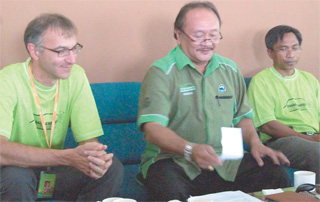Expedition outcome to help Sabah parks
Published on: Wednesday, September 26, 2012

Penampang: Sabah Parks Board of Trustees Deputy Chairman Patrick Jilan said the scientific facts gathered during the recently concluded Kinabalu Crocker Range Scientific Expedition 2012 will be invaluable for the planning and management of Sabah Parks.He said the variety of research activities conducted in several locations provided a wide range of scientific data which can help Sabah Parks interpret more details about the uniqueness of nature and the richness of biodiversity within Kinabalu and Crocker Range Park."I am sure the scientific facts generated by this expedition would be invaluable and useful for Sabah Parks to formulate a better action plan for better park management in the future," he said during the closing of the Kinabalu Crocker Scientific Expedition 2012 at the Inobong SubStation, here, Tuesday.
ADVERTISEMENT
He said although the results of the research have not been analysed yet he was made to understand that some new findings were speculated from the expedition."I do believe that there are high potential of new findings of new species within the these two park areas that are not yet fully explored especially the Crocker Range park. So I would like to acknowledge your commitment and contribution in helping us document the uniqueness of our natural resources here," said Patrick.The expedition which started two weeks ago was jointly participated by 54 local scientists from Sabah Parks, Universiti Malaysia Sabah, Forest Research Centre and Unimas and international scientists from the Naturalis Biodiversity Centre (NBC), Holland.According to NBC Director Dr Edwin Van Huis the aim of the expedition was to understand the origin of the species endemic to Mt Kinabalu, Mt Alab and the high mountains in Sabah.
ADVERTISEMENT
"So to do that we need to get DNA samples from species that live on the summit and lowlands so experts on various kinds of plants, animals and fungi have collected close to 8,000 specimens of 1,400 different species and of that ten percent are species that are endemic on Mt Kinabalu or Mt Alab."What we have taken are tissue samples from these species and these are going to be brought to the DNA labs in Naturalis Biodiversity Centre in the Netherlands where the DNA will be sequenced and coded and the DNA information will be used to build family trees of each of those groups and the family trees will tell us whether the endemic species are old or relics of long ago and are just surviving on top of the mountain or if they are new species which have recently split off from lowland species."
ADVERTISEMENT
He said the samples of the expedition needed to be processed, categorised and analysed and as such the results may take up to a year before they can publish the results of their findings. He said he was made to understand that Sabah Parks was also interested in setting up their own lab and the centre was very willing to give support and training for that purpose. According to Sabah Parks Assistant Director (Research and Education) Dr Maklarin Lakim, it was the first time an expedition was held to try to find the answers of the origin of existence of the unique species that can be found on these mountains.Stay up-to-date by following Daily Express’s Telegram channel.
Daily Express Malaysia




